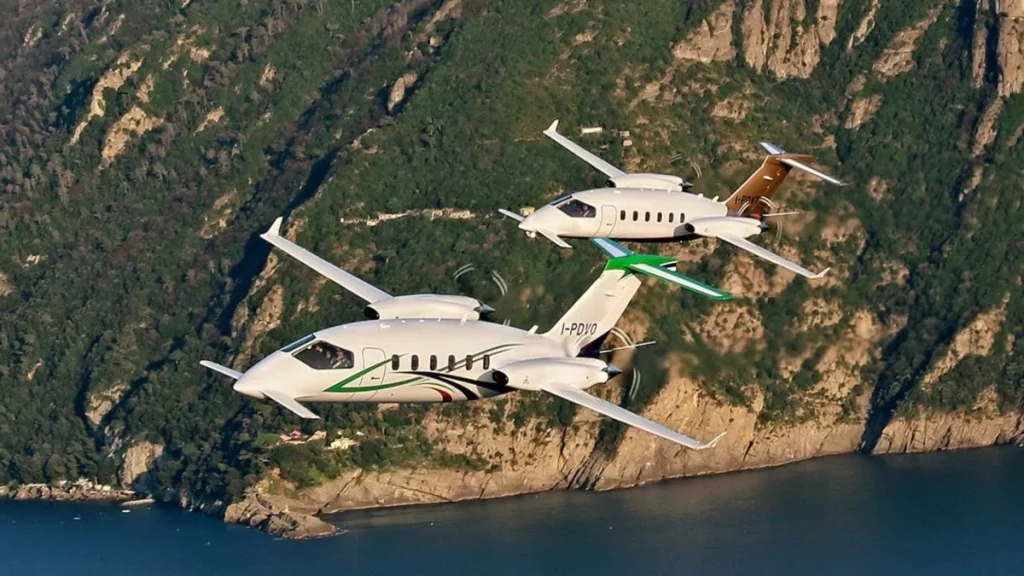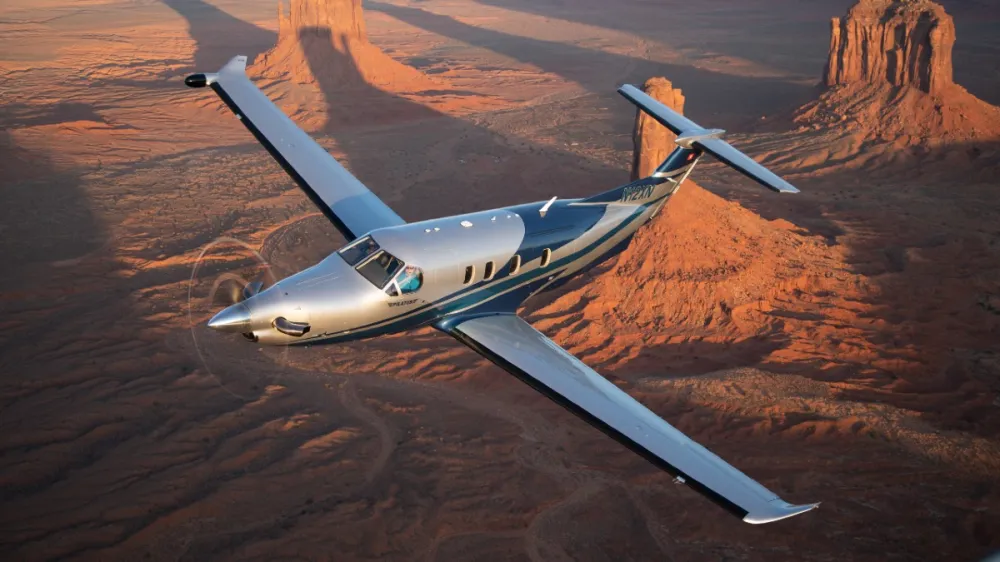Turboprops are morphing into new forms, from the jet-like Avanti P180 to the iconic, multi-mission Grand Caravan to the amphibious Twin Otter 400.
The utilitarian turboprop has long been in the shadow of smaller business jets, seen largely as a poor cousin to the faster, glitzier jets. But there has been impressive development in the turboprop world, driven by a renaissance in new technology as well as lower carbon emissions and reduced operating costs compared to most business jets.
Turboprops also fit nicely into a niche between light airplanes and business jets, making more sense as regional commuters—especially into remote airfields—than many jets, thanks to lower operating costs, decent speed and range, and fuel efficiency. A number have the capability of landing on dirt, gravel, grass, water or even snow. Many private fliers are willing to take the lower altitude and noisier cabins as tradeoffs for the benefits.
But the truth is that turboprops have evolved to be competitive with many jets. While many serve humanitarian missions carrying freight or as air ambulances, airframers like Daher and Textron Aviation continue to add luxe features to their executive versions to deliver a more jet-like experience. As a regional business option, the turboprop remains a go-to favorite.
Here are our nine favorites.

Beechcraft King Air 360
Beechcraft’s King Air models have earned royalty status, thanks to more than 50 years of service and a fleet size topping 3,100. The eight- to nine-passenger King Air 360 is the latest in the Beechcraft lineup, which many pilots hail for its efficiency, ability to handle heavier loads, and utility. Powered by two Pratt & Whitney Canada PT6A-60A turboprop engines, it has a range of 1,800 nautical miles, a maximum cruise speed of 312 knots, and a maximum ceiling of 35,000 feet.
The latest iteration includes extras like a digital pressurization system for lower cabin altitude, Onboard Maintenance System (OMS) updates, full autothrottle, and interior enhancements. The two-zone cabin’s redesigned leather seats articulate in four directions and fully recline. It also has 71 cubic feet of luggage space. Its proprietary QuietZone tech reduces cabin noise while the the CoolView windows, updated lighting, and temperature controls enhance the flight experience.

Cessna Grand Caravan EX
Cessna’s Grand Caravan can boast a few impressive stats. It is the largest single-engine airplane in production, with more than 3,000 being delivered worldwide since the Caravan 1 launched in 1984. While this turboprop family has undergone multiple iterations 40 years, there are two important constants from the original design: It’s big and designed for multiple missions.
The Grand Caravan has served all over the world with a versatility no other turboprop can match: carting freight for FedEx, military missions, amphibian flights with floats, passenger transport, air ambulances, and delivering humanitarian aid.
Four models are now in production, including the 208 Caravan, 208 Grand Caravan EX (pictured), Caravan Amphibian, and Grand Caravan EX Amphibian. Powered by Pratt & Whitney Canada’s 675-horsepower PT6A-114 turbine engine, today’s Caravan can fly a maximum range of 1,070 nautical miles. Its maximum cruise speed is 186 knots. It can take off from just 1,160 feet, while the landing distance is 1,625 feet. It’s certified to operate on grass, gravel and even rougher runway conditions. Depending on the configuration, it can accommodate 10 to 14 occupants.

Beechcraft King Air 260
A relative newcomer with the larger King Air 360, the King Air 260 replaced the 250 in 2020. Its stats are impressive—maximum range of 1,720 nautical miles; top cruise speed of 310 knots—but so are the size and operational costs. It can accommodate up eight passengers, with a modern cabin that features reshaped cabinetry, new seat designs, and CoolView windows. Like the 360, it also has Collins Aerospace Pro Line Fusion Avionics suite and a ThrustSense autothrottle system. The avionics suite also includes synthetic vision and multi-scan weather readouts.

Daher TBM 960
Daher’s newest turboprop features the PT6E-66XT engine by Pratt & Whitney Canada, enhanced with a dual-channel digital Engine and Propeller Electronic Control System (EPECS), while the cockpit features Garmin’s G3000 avionics suite and Garmin’s HomeSafe emergency autoland system.
The TBM 960 has a cruise speed of 330 knots and range of 1,730 nautical miles. It competes favorably with other turboprops and even some light jets, offering speed and range with the advantages of turboprop efficiency. The aircraft offers reduced fuel consumption at eco-cruise settings, with a five-blade composite Raptor propeller that contributes to lower noise levels and improved performance.
The cabin has upscale features like electronically dimmable windows, LED ambient lighting, and environmental control systems. The ergonomically designed seats are electrically heated. Other amenities such as a lateral folding table, USB-A and USB-C ports, and SiriusXM satellite music and radio enhance the experience.

Pilatus PC-12 NGX
This single-engine turboprop aircraft can go almost anywhere, including grass runways. Its low operating costs (up to a third less than a comparable twin-engine aircraft) help to explain why the fleet size is approaching 1,000 since it was introduced in 2008. Its versatile flight and landing capabilities and efficiency have made the aircraft popular as executive transport, air ambulances and commuter aircraft.
The most recent iteration, the PC-12 NGX, is powered by a Pratt & Whitney Canada PT 6A-67B, delivering a cruise speed of 290 knots and range of 1,300 nautical miles. The aircraft has a stall speed of 67 knots and a takeoff distance of just 1,670 feet. Its cabin was styled by BMW and can accommodate up to 10 passengers. The cockpit utilizes the Honeywell Primus Apex avionics suite.

Piaggio Avanti P180 Evo
Piaggio Aerospace’s Avanti P180 Evo is faster (maximum speed of just over 400 knots) than some jets, but at a fraction of their operating costs. Recent upgrades extending its range, a faster climb rate, enhanced safety features, and other passenger pleasers secured its place on this list.
The third-generation Avanti P180 Evo is powered by two Pratt & Whitney Canada PT6A-66B wing-mounted turboprop engines. With seating for eight (plus two flight crew), the P180 has a maximum range of 1,809 nautical miles (say from Chicago to Los Angeles), with a service ceiling of 41,000 feet.
The pressurized cabin has headroom of 5’9”, which Piaggio says is the largest in its class, combined with a width of just over six feet. The interior features bench and club seating, with the option of Poltrona Frau leather upholstery. The aircraft is wired for broadband and satellite connectivity.

Beechcraft Denali
Textron’s Beechcraft Denali is a high-performance, single-engine turboprop designed for versatility. The Denali is powered by the GE Aerospace Catalyst 1300 CS1A engine, which ranks as the first clean-sheet turboprop design in 30 years. The aircraft has a maximum range of 1,600 nautical miles and maximum cruise speed of 285 knots.
There are some cool tech angles to the new engines, including fewer parts and some being made via 3-D printing. For avionics, the Garmin G3000 offers intuitive touchscreen controls, autothrottle, emergency Autoland, synthetic vision, and other safety and operational features.
This aircraft can accommodate up to 11 occupants, with choices including the six-seat executive or nine-seat commuter configurations. The sizable pressurized cabin is engineered for comfort and functionality, featuring large windows for natural light. The executive configuration offers a club-seating arrangement with a refreshment center, while the airframe design includes cargo doors to accommodate different missions.

Daher Kodiak 900
Our other favorite Daher-owned aircraft, the Kodiak 900, is a single-engine turboprop that combines the rugged utility of the iconic Kodiak 100 with the robust capabilities of Daher’s TBM series. The aircraft sports a Pratt & Whitney PT6A-140A engine, for a maximum cruise speed of 210 knots and extended range of 1,129 nautical miles. The Kodiak 900 can take off in just 1,015 feet.
This new Kodiak stands out for its low operating costs, advanced avionics, adaptable cabin space, and versatility in a variety of environments—from busy city airports to remote airstrips. The aircraft’s design incorporates advanced aerodynamics, including a high-lift wing and rugged landing gear, enabling it to operate from short and also rough fields. In the cockpit, the aircraft utilizes the Garmin G1000 NXi avionics suite, featuring a GFC 700 autopilot with Electronic Stability Protection.
The cabin can be configured for up to 10 passengers and can quickly transform from passenger to cargo configurations, providing flexibility for business operations, with amenities such as USB charging ports and an optional air-conditioning system.

Viking Twin Otter 400
The rugged Twin Otter Series 400 packs utility and performance into a twin-engine turboprop designed for harsh environments, with seating for up to 19 passengers. Two Pratt & Whitney Canada PT6A-34 engines power this high-winged aircraft. The Twin Otter has long been recognized for its short takeoff and landing capabilities, with the ability to operate on different surfaces, including areas lacking infrastructure. It can be fitted with floats (with retractable landing gear) or skis.
The aircraft has a cruising speed of just 160 knots and a range of approximately 775 nautical miles. The takeoff distance is 1,200 feet, while it can land in just 1,050 feet. Recent updates to the avionics include a Honeywell Primus Apex integrated avionics suite.
The Twin Otter can be reconfigured for varying roles, from commuter to medevac services, but the common opinion is that passenger transport is its sweet spot.








